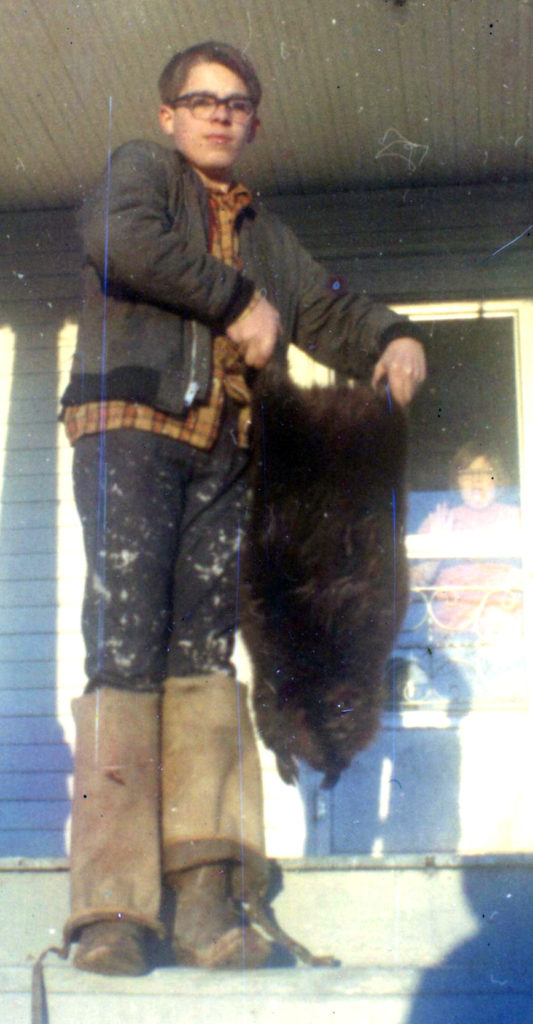
My first trapping successes were barn rats, woodchucks, possum, and cottontail rabbits caught in a wooden box trap. My trapline was the first 10 yards of wild growth outside our lawn. For a six year old, these creatures and the environment in which they were found were my exotic quarry and their jungle. I didn’t catch a lot. I had no thought of what fur was. The challenge kept me occupied for hours.
To this day, I don’t know how even a youngster could spend so much time “trapping” when he only had one box trap. Regardless of not figuring out what filled those hours, I thoroughly enjoyed the pursuit – learning about the animals, trying new locations and baits, and having the exhilaration of a catch.
I didn’t skin the catches. The barn rats and woodchucks were killed. That was a mandate from my parents. The possum and rabbits were usually kept in a wire cage for a few days. I fed and watered them. I watched them every moment I was able. It gave me a connection to them. Then they were released – hopefully to be wiser. And I reset the box trap – hopefully to recapture them.
Add a year or two and my dad introduced me to #1 longsprings and muskrat runs. About that same time I began to range into nearby woodlots. Raccoon were now in my grasp.
Coon were a challenge. They were my big game. It took me a bit to catch each one and they were hard to hold. That was my inexperience showing. They kept me coming back for more – exploring small woods’ runs and grape tangles. I started to figure them out. I was now getting proficient at catching (and holding) muskrats and coon.
While I was growing up, the statewide bag limit here was three beaver. They were not very populous and the regulations were pretty strict. They became my new big game. Beaver were scarce. They were big. They brought out the explorer in me and presented an entirely new set of challenges. I knew of one beaver within my reach. It was a bank beaver on the river that flowed through town. Just over the hill from the hospital a small oxbow in the river had some of his cuttings and clippings. It housed his winter brush pile.
Crawling over and around chunks of ice, reminding me of Arctic pressure ridges, I made my way to the downstream point where the oxbow and river channel rejoined. A bit of open water allowed me to make a bait set with poplar. The trap was a #21/2 Blake & Lamb single longspring. It seemed like a beaver-sized muskrat trap I bought from the local fur dealer.
It took a few days, but I finally got the beaver. It was a youngster of 20 pounds. To me, it was a monster critter. I was so proud of that catch.
That was the only beaver I caught for quite a few years. As I said, they were not that common at the time.
As the years passed, I upped my game. The challenges continued and shifted from season to season. I graduated to gray fox, red fox, coyote, mink, fisher, bobcat, and weasel. I became more experienced and enjoyed each and every victory.
That’s the neat thing about trapping. We can become longliners and look for a payday. That being said, the thrill of the pursuit is always there – even if we only have half a dozen traps and need to squeeze out every moment from our schedules to get out to set them. The payday is great when prices are high. That is the bonus. The real reward, the real payoff, is the ability to become one with nature. We tromp the fields, experience the weather beating our faces, and try to figure out the misses. We become an integral part of Mother Nature’s cycles. We are no longer simply observers. We are active participants.
As time moves on, I have seen the transition of furbearers march through my sights. My first fur trapping was for muskrat, then raccoon, beaver, and so on. I am now revisiting many species I have trapped to become more proficient at trapping them. In the near future I’m looking to concentrate on gray fox, otter and weasel. These will be different lines at different times. The fur prices aren’t even a consideration.
The different species all offer a thrill. It makes me feel so good to see many trappers targeting weasel or even spotted skunk. It is amazing how a small mammal can so capture a trapper’s imagination and become his prize. These prizes are worth many times more than any fur dealer’s offer. •
